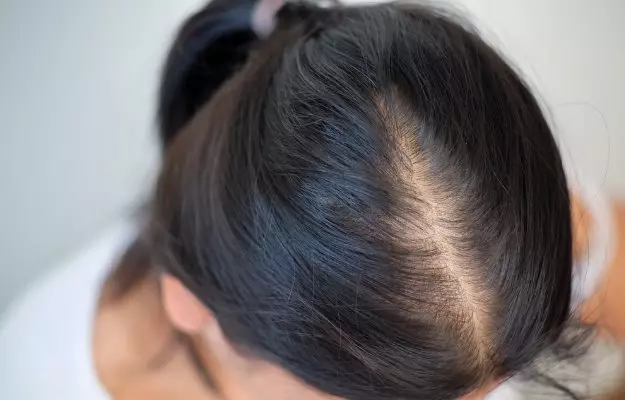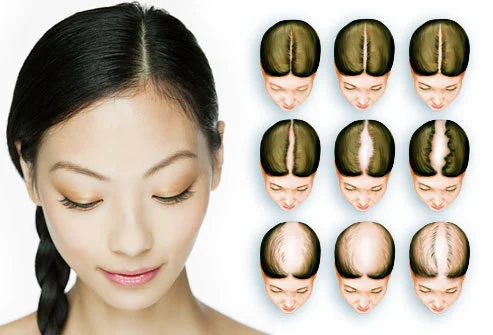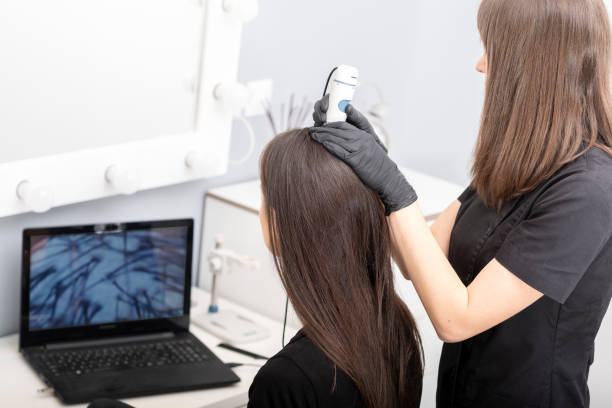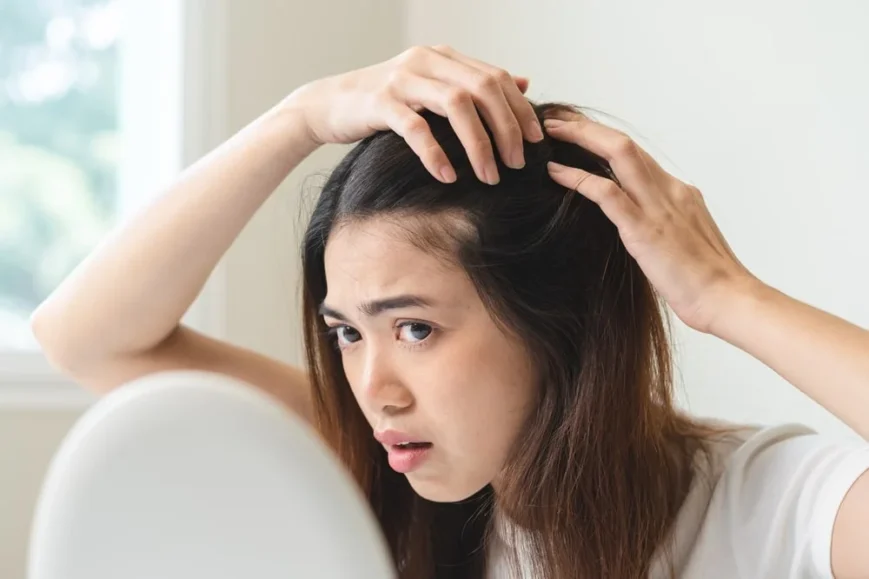Millions of women worldwide suffer from a prevalent yet frequently misdiagnosed illness known as female pattern baldness (FPB).
In difference to male pattern baldness, which is well-known and acknowledged, FPB is commonly disregarded or incorrectly diagnosed, which causes those who are impacted to feel ashamed and alone.
Definition of Female Pattern Baldness:
A congenital hair loss that mainly affects women, baldness is often referred to as androgenetic alopecia. Reduced hair density and a widening part line result from progressive hair thinning on the top of the head and crown. FPB exhibits a characteristic pattern of hair thinning that usually begins in the centre of the scalp and gradually spreads outward, in contrast to other kinds of hair loss.
Importance of Raising Awareness:
It is essential to raise awareness of Female Pattern Baldness for several reasons. At the beginning, many women might not realize that hair loss affects people of all ages, including teenagers and young adults. It is not just a problem for Male Pattern Baldness and older persons. We can fight the misconception that hair loss is exclusively a male issue and provide support and resources to women who are struggling with this illness by increasing awareness of FPB.
Moreover, more excellent knowledge can result in early detection and treatment, giving women access to efficient therapies and halting additional hair loss. Promoting candid discussions around FPB and disseminating precise information may enable women to take charge of their hair health and make knowledgeable decisions about their maintenance.
What is Female Pattern Baldness?

Female Pattern Baldness (FPB), known as androgenetic alopecia, is a common form of hair loss primarily affecting women. It is characterized by progressive hair thinning on the scalp, particularly in the frontal and crown regions, resulting in a widening part line and reduced hair density.
Unlike other types of hair loss, FPB follows a distinct pattern of hair thinning, typically starting at the centre of the scalp and spreading outward over time. While FPB does not usually lead to complete baldness in women, it can significantly impact self-esteem and quality of life.
Explanation of Female Pattern Baldness (FPB):
The primary causes of FPB are primarily genetic and hormonal. Dihydrotestosterone (DHT) is a critical factor in developing FPB in women. Because it attaches to receptors in the hair follicles, testosterone-derived DHT causes the follicles to contract and create shorter, thinner hairs. Affected hair follicles may eventually go dormant and stop growing new hair, which can result in noticeable hair loss and thinning.
Key Differences between Male and Female Pattern Baldness:
While male Pattern Baldness and female pattern baldness share similarities, there are several key differences between the two conditions:
Prevalence and Statistics:
Female Pattern Baldness is more common than many people realize, affecting approximately 30 million women in the United States alone. While FPB is more prevalent in older women, it can occur at any age, with some women experiencing noticeable hair loss in their teens or twenties.
The prevalence of FPB tends to increase with age, with up to 50% of women over 65 experiencing some hair thinning. Despite its prevalence, FPB is often underdiagnosed and undertreated, highlighting the need for increased awareness and education surrounding this condition.
Causes of Female Pattern Baldness:
- Hormonal Factors:
- Genetic Predisposition:
- Age-Related Factors:
- Other Contributing Factors:
Understanding the various causes and contributing factors of Female Pattern Baldness is essential for effective management and treatment. Women can proactively manage FPB and promote healthy hair growth by addressing underlying hormonal imbalances, genetic predispositions, and lifestyle factors.
Consult your doctor about hair-supporting supplements like biotin or iron, particularly if you are deficient.
Symptoms and Stages

Certainly! Let’s explore the stages of female pattern baldness according to the Sinclair scale in more detail:
- Stage : Little or No Hair Loss
- At this early stage, women may not notice significant hair loss.
- Hair density remains relatively normal, with no visible gaps or thinning areas.
- Paying attention to any changes in hair texture or volume is essential.
- Stage : There is a slight Gap in the Center Hair Part
- In stage 2, women may observe a subtle widening of the centre part.
- The gap is usually minor but indicates the beginning of hair thinning.
- Hair follicles may start producing shorter and finer hairs.
- Stage : Wider Gap in the Center Part with Hair Loss on Either Side
- At this point, the gap in the centre part becomes more noticeable.
- Hair loss extends beyond the centre, affecting both sides of the scalp.
- Thinning may be more evident near the temples and crown.
- Stage : Bald Spots Near the Front Hairline
- Stage 4 involves more significant hair loss.
- Women may develop bald spots near the front hairline (receding hairline).
- Thinning becomes apparent in other areas as well.
- Stage : Advanced Hair Loss
- In the final stage, hair loss is extensive.
- Large bald areas may form on the scalp.
- The remaining hair becomes sparse, and the scalp becomes increasingly visible.
Remember that the Sinclair scale visually represents female pattern baldness, allowing healthcare professionals to assess the severity. If you’re experiencing hair loss, consider seeking advice from a dermatologist or a hair specialist for personalized guidance and treatment options.
How to Recognize Early Signs of FPB:
Recognizing the early signs of Female Pattern Baldness is essential for timely intervention and management. Here are some tips for identifying early signs of FPB:
- Pay Attention to Changes in Hair Density: Be mindful of any changes in hair density, particularly on the crown or top of the scalp. If your hair appears thinner or less voluminous in these areas, it may be a sign of FPB.
- Monitor Your Part Line: Regularly check the appearance of your part line for any widening or increased visibility of the scalp. A widening part line can indicate early hair thinning associated with FPB.
- Assess Hair Texture and Quality: Notice any changes in the texture and quality of your hair, such as increased fine hairs or a reduction in hair volume. These changes may indicate underlying hair follicle miniaturization characteristic of FPB.
- Track Hair Shedding: Monitor any changes in hair shedding or loss, particularly during routine activities such as washing or styling your hair. Excessive shedding or noticeable hair loss may warrant further evaluation by a healthcare professional.
- Converse with a Healthcare Professional: Schedule a consultation with a dermatologist or other healthcare professional for a comprehensive assessment if you believe you may be exhibiting symptoms of Female Pattern Baldness. The progression of FPB can be slowed down, and existing hair density can be preserved with early diagnosis and treatment.
Women should take proactive measures to treat Female Pattern Baldness and preserve healthy hair development by identifying early signs and symptoms and getting appropriate medical help.
Top 7 proven Treatments for Female Pattern Baldness:
- Medications:
- Red Light Therapy:
- Low-Level Laser Therapy (LT):
- Platelet-Rich Plasma (PRP) Therapy:
- Hair Transplantation:
- Styling Techniques:
While styling won’t reverse hair loss, it can help conceal thinning areas:
- Professional Guidance:
Remember that individual responses to treatments vary; what works for one person may not work for another. Encourage your readers to seek professional guidance and explore the options that suit their needs.
Get between seven and eight hours of sleep every night to promote hair development and general wellness.
Psychosocial impact of Female Pattern Baldness:
- Emotional Stress, Anxiety, and Depression:
- While female pattern baldness doesn’t directly affect physical health, it can significantly impact emotional well-being.
- Women experiencing hair loss often feel self-conscious, anxious, and stressed.
- The fear of being judged or feeling less attractive can lead to emotional distress.
- Coping with changes in appearance can be challenging, especially when societal beauty standards emphasize thick, lustrous hair.
- Societal Perceptions and Self-Image:
- Society often associates thick, healthy hair with femininity, youth, and beauty.
- Women with female pattern baldness may face societal pressure to conform to these ideals.
- Self-image can suffer as a result, affecting confidence and self-esteem.
- Some women wear wigs, scarves, or hats to conceal hair loss, which can impact their sense of identity.
- Support and Coping Strategies:
- Encourage women experiencing hair loss to seek emotional support from friends, family, or support groups.
- Professional counselling or therapy can help address emotional challenges.
- Focusing on other aspects of self-worth (such as talents, personality, and achievements) can mitigate the impact of hair loss on self-esteem.
Remember that empathy and understanding are crucial when discussing female pattern baldness. Acknowledging the emotional aspects can create a more compassionate and supportive environment for those affected.
Diagnosis of Female Pattern Baldness (FPB):

- Consulting a Healthcare Professional or Dermatologist:
Importance of Expert Evaluation:
Differential Diagnosis:
Access to Advanced Diagnostic Tools:
- Physical Examination and Medical History:
Assessment of Hair Loss Patterns
Review of Medical History:
- Additional Diagnostic Tests:
Blood Tests:
Scalp Biopsy:
Seeking professional evaluation ensures accurate diagnosis and personalized treatment plans, leading to effective management of Female Pattern Baldness and preservation of hair density.
Prevention Tips for Female Pattern Baldness:
- Early Detection and Intervention:
- Maintaining a Healthy Lifestyle:
- Avoiding Harsh Hair Treatments and Styles:
- Stress Management Techniques:
By incorporating these prevention tips into your lifestyle, you can support hair health and minimize the risk of Female Pattern Baldness. Early detection, healthy lifestyle, gentle hair care practices, and stress management are critical components of preventing and managing hair loss in women.
Make sure your diet is full of the elements that support healthy hair, such as iron, protein, and the vitamins A, B, C, D, and E.
Conclusion: Empowering Women Living with Female Pattern Baldness
We’ve explored the multifaceted aspects of Female Pattern Baldness (FPB), including its causes, symptoms, diagnosis, and treatment options. It’s essential to recognize the importance of early detection and intervention and the significance of maintaining a healthy lifestyle and managing stress.
Seeking professional help from dermatologists or healthcare providers is crucial if experiencing symptoms of FPB, as timely diagnosis and treatment can slow down hair loss progression and improve outcomes. To all women living with FPB, I want to convey a message of hope and empowerment. Your hair does not define you, and your worth extends beyond physical appearance.
Embrace your unique beauty, cultivate self-confidence, and remember you are not alone. Support is available, and together, we can navigate the challenges of living with Female Pattern Baldness with resilience and strength.
FAQs
-
What symptoms and indicators are present in female pattern baldness?
Miniaturization of hair follicles, thinning hair on the crown or top of the scalp, a widening part line, and increased shedding or hair loss, especially during hair washing or style, are signs and symptoms of FPB.
-
Is female pattern baldness treatable or preventable?
Although it is impossible to avoid Female Pattern Baldness altogether, some lifestyle modifications and therapies can help slow the rate at which hair loss progresses and encourage hair growth. Low-level laser therapy (LLLT), oral drugs like finasteride, topical drugs like minoxidil, and hair transplantation are available forms of treatment.
-
Is Female Pattern Baldness Reversible?
Although there isn’t a cure for Female Pattern Baldness, medication can help promote hair growth and slow down the rate at which hair loss progresses. However, individual characteristics, such as the degree of hair loss and responsiveness to treatment, may affect a treatment’s effectiveness.
-
Is baldness on the female pattern inherited?
Due to a significant genetic component, female pattern baldness frequently runs in families. A family history of hair loss improves the likelihood that a woman may experience FPB. Identifying particular genes linked to the susceptibility to FPB provides additional evidence for the involvement of genetics in the disorder.
-
Does a woman inherit her baldness?
Female pattern baldness typically runs in families since it has a significant genetic component. The chance of having FPB in oneself is increased in women with a family history of hair loss. Further evidence for the importance of genetics in the disorder comes from identifying particular genes linked to FPB vulnerability.
-
Do male and female pattern baldness have the same characteristics?
Despite having similar genetic predispositions and hormonal factors, female and male pattern baldness can appear in different ways. The typical symptom of female pattern baldness is broad hair thinning throughout the scalp. Male pattern baldness, on the other hand, typically has a more pronounced pattern of hair loss, including thinning at the crown and a receding hairline. Furthermore, whereas male pattern baldness may result in the recession of the hairline, female pattern baldness typically spares the hairline.
-
When does female pattern baldness usually begin to appear?
Although female pattern baldness can occur at any age, postmenopausal women are more likely to have it. On the other hand, some women may noticeably begin to lose hair in their teens or twenties. Individual differences can be seen in the age of onset and rate of advancement, which lifestyle choices, hormonal changes, and heredity may impact.

